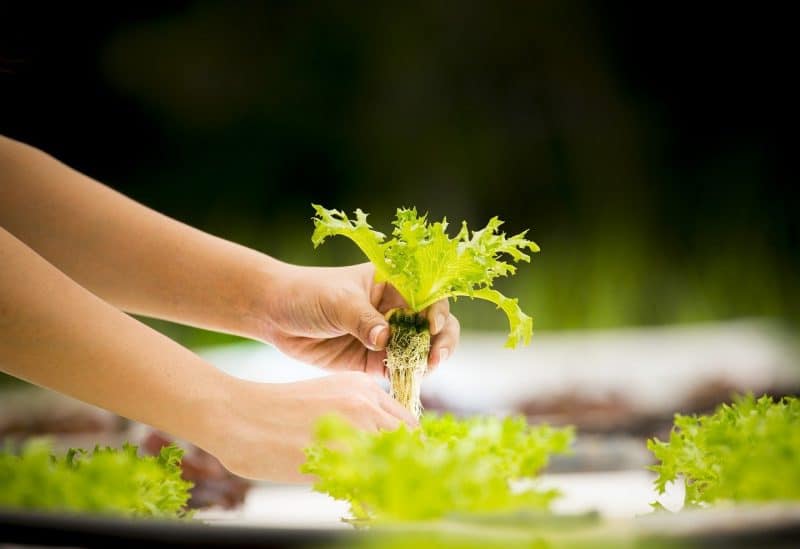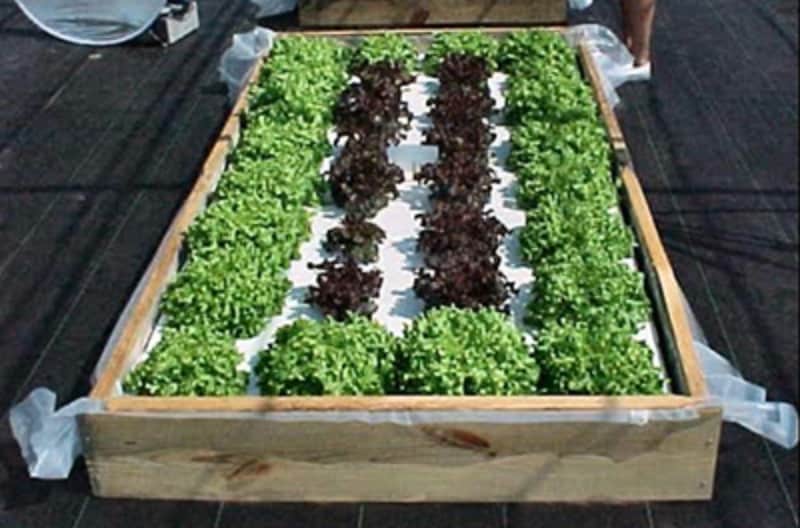This post contains affiliate links. If you buy something from one of our links we may earn a commission. Thanks

Explore the joys of an indoor hydroponic vegetable garden! Discover tips for easy setup and growing fresh, healthy veggies in your own space.
Are you thinking about starting an indoor hydroponic vegetable garden? Using apartment hydroponics you can grow vegetables without soil.
Hydroponic Vegetables Key Takeaways:
- An indoor hydroponic vegetable garden allows you to grow fresh vegetables all year round without soil.
- It’s an efficient, soil-free way to produce healthy, chemical-free produce right in your home.
- Using passive methods like the Kratky system allow for a sustainable, space-saving gardening solution.
Starting An Indoor Hydroponic Vegetable Garden
Dreaming of fresh veggies year-round? With an indoor hydroponic vegetable garden, it’s possible!
This guide unveils how you can transform your home into a green haven, growing a variety of vegetables without soil.
Dive into the world of hydroponics and enjoy the harvest of your own indoor garden!
Why starting a hydroponic vegetable garden in your apartment makes sense.
- You will be growing your own food.
- It is also an educational experience that is great to share with kids.
- It can be a lot of fun and you will learn a lot.
- There is a special satisfaction in eating food you grew yourself.
- You can grow healthy food that is not sprayed with chemicals like the stuff in the supermarket.
Apartment Kitchen Garden – Growing A Hydroponic Garden In An Apartment (indoorvegetablegrower.com)
What vegetables can be grown hydroponically indoors?
You can grow many different vegetables indoors. Hydroponics has many different ways to grow vegetables.
Some, like DWC (deep water culture) or flood and drain systems, are adapted to growing larger plants like tomatoes and peppers.
The Kratky method allows you to grow smaller plants like microgreens, herbs and lettuce.
What is the easiest vegetable to grow hydroponically?
The easiest vegetables to grow hydroponically are microgreens, herbs, and lettuce.
All leafy greens and herbs are easy to grow in hydroponics and mature much faster than fruiting plants.
Many greens can be harvested multiple times by just removing individual leaves rather than pulling up the whole plant.
How do I start an indoor hydroponic garden?
This is really not much different than starting an outdoor garden. You need to decide what you will grow, and where you will put it.
The 2 biggest differences are that you will not use soil to grow your plants, and you will need to set up a light fixture to provide supplemental light.
If you have a patio or balcony, you will have enough light in the summer. Otherwise, you will need a grow light.
But starting an indoor hydroponic vegetable garden will allow you to grow vegetables all year round, and you will need a grow light for this.
More info at https://indoorvegetablegrower.com/growing-vegetables-indoors-with-lights/
How do I set up an indoor hydroponic system?
There are a few different hydroponic systems, and some are definitely easier and cheaper to set up and use.
The best hydroponic system for beginners is undoubtedly the Kratky system.
If you have never grown anything, or this is your first try at growing hydroponically, this is where you should start growing greens like lettuce.
Even if you want to grow harder-to-grow plants like peppers or tomatoes, I suggest getting your feet wet with the Kratky system.
The Kratky system is a passive form of DWC and that means no pumps are needed.
It is self-contained in a tote or any container that can hold water, so all you need is a tote with a top or a piece of Styrofoam the same size.
You can even grow lettuce in a mason jar using this method. Here is some more information for you:
https://indoorvegetablegrower.com/kratky-lettuce-kratky-method-hydroponic-system-diy/
Lighting Your Indoor Hydroponic Vegetable Garden
No matter what vegetables you grow or how you decide to grow them, your vegetables will need supplemental lighting.
All vegetables are outdoor plants used to getting plenty of sunshine, and even those that have lower light needs still need a lot of light.
In the winter, days are much shorter, and the skies are often cloudy. There is no way to grow vegetables indoors without supplementing light.
LED Grow Lights Are The Best Choice
LED grow lights give off more light per watt of power used than any other type of lighting. They also dont give off a lot of heat.
Fluorescent lights can be used for lower light plants, but they are not as efficient and you will need to replace the bulbs every year.
They probably can’t give off enough light for high-light crops like tomatoes.
You will need about 30-35 watts per square foot for these. Please be aware that many Chinese LED manufacturers inflate the wattage of their lights by adding up the wattage of each individual chip.
However, their lights are not designed and do not run at 100% power. The actual wattage of an LED is determined by the number of watts they pull from the wall.
There are a lot of LED lights on the market today, and everyone claims theirs is the best.
If you want premium lights, check out Horticulture Lighting Group. They are top quality and made in the USA.
If you don’t want to spend that much, I recommend looking at Spider Farmer lights. They are good quality and more affordable.
Enhance Performance With A Grow Tent
Using a grow tent can enhance the performance of your vegetables. The inside of a grow tent has reflective walls that will make your light more efficient.
If you hang a grow light in an open space, the light will spread. A lot of light is wasted because it isn’t hitting your plants.
LED lights are also pretty bright, so you might want to put them in a grow tent for that reason alone.
But the light they give off is enclosed inside the tent, and the walls reflect it back towards your plants.
So your light will perform much better and so will your veggies.
So check out my article on Using A Grow Tent For Vegetables [ Ultimate Quick-start Guide ] (indoorvegetablegrower.com) for more information on using a grow tent.
You can also find instructions to set up water and set up the water reservoir and how to set up an automated flood and drain system in your tent.

Here is an article that shows how to build a simple hydroponic system using the Kratky method.
This is a lettuce raft system, and this method really works and is used commercially on a larger scale
Growing Hydroponic Vegetables FAQs
Do you have questions about indoor hydroponic vegetable gardens? We’ve got answers!
Whether you’re curious about the feasibility, challenges, or the best crops for hydroponics, we cover it all.
Dive into these FAQs to kickstart your hydroponic gardening journey.
Q: Can you grow hydroponic vegetables indoors?
A: Absolutely! Indoor hydroponic vegetable gardening allows you to cultivate a variety of vegetables within your home, regardless of outdoor space or climate.
By controlling the environment, including light, water, and nutrients, you can achieve optimal growth conditions for plants like lettuce, tomatoes, herbs, and more, all year round.
Q: What are 3 disadvantages of hydroponics?
A: The 3 disadvantages of hydroponics are:
1. Initial Cost: Setting up a hydroponic system can be expensive, with costs for equipment like grow lights, nutrient solutions, and growing mediums.
2. Constant Monitoring: Hydroponic systems require regular monitoring and maintenance to ensure the right balance of nutrients and pH levels, as well as to prevent issues like algae growth or system blockages.
3. Dependence on Electricity: Hydroponics systems often rely on electricity for lighting and circulating water, making them vulnerable to power outages and potentially increasing your energy bills.
Q: Are indoor hydroponic gardens worth it?
A: Yes, indoor hydroponic gardens are worth it for several reasons.
They offer a year-round supply of fresh produce, efficient use of space, and lower water usage compared to traditional soil gardening.
They also reduce the need for pesticides, providing healthier and cleaner produce.
While there’s an initial investment and learning curve, the long-term benefits of freshness, taste, and convenience make it a worthwhile endeavor.
Q: What vegetables cannot be grown hydroponically?
A: While most vegetables can be grown hydroponically, root vegetables like carrots, potatoes, and beets can be challenging due to their growth patterns and space requirements.
These vegetables often require a deeper growing medium and more space to expand, which can be difficult to accommodate in standard hydroponic setups.
But they can be grown in large 5-gallon buckets and I do it all the time using coco coir as a hydroponic medium.
I would not try to grow succulents or cacti in a hydro system.
Q: What is the easiest vegetable for hydroponics?
A: Leafy greens like lettuce, spinach, and kale, along with herbs such as basil, mint, and cilantro, are among the easiest vegetables to grow hydroponically.
These plants have relatively short growth cycles, are less demanding in terms of light and nutrients, and can be harvested multiple times, making them ideal for beginners.
Q: Do tomatoes do well in hydroponics?
A: Yes, tomatoes are well-suited for hydroponic cultivation. They can produce higher yields and faster growth compared to soil gardening when given the right conditions.
However, they require more attention to factors like nutrient concentration, pH levels, and adequate support as they grow.
Q: What is the best hydroponic garden for beginners?
A: The Kratky method is an excellent choice for beginners. It’s a passive hydroponic system that doesn’t require electricity or pumps, making it simple and cost-effective.
It’s ideal for growing leafy greens and herbs, providing a great way to learn hydroponic principles without complex equipment.
Q: Can cucumbers be grown hydroponically?
A: Yes, cucumbers can be grown successfully in hydroponic systems. They are well-suited for methods like the Dutch Bucket or Deep Water Culture (DWC) due to their need for more space and support as they grow.
Cucumbers in hydroponics often produce higher yields and faster growth than soil-grown counterparts.
However, they require careful management of nutrients, consistent water quality, and proper trellising to support their vines and fruit.
Regular pruning and monitoring for pests and diseases are also important to ensure a healthy, productive cucumber crop in a hydroponic setup.
Indoor Hydroponic Vegetable Garden Conclusion
Embarking on your indoor hydroponic vegetable garden journey is a step towards sustainable, healthy living.
From selecting the right system to choosing suitable crops, this guide has equipped you with the essentials.
Whether you’re a beginner or an experienced gardener, hydroponics opens up a world of possibilities for year-round gardening.
Give it a try and taste the difference in your own fresh, home-grown vegetables!
Remember, patience and learning are key to a bountiful harvest
Embarking on your indoor hydroponic vegetable garden journey is a step towards sustainable, healthy living. This guide has equipped you with the essentials to get started.
Here are some final takeaways:
• Choosing the Right System: Start with a simple system like the Kratky method, especially if you’re a beginner.
• Selecting Suitable Vegetables: Begin with easy-to-grow options like leafy greens and herbs, then experiment with fruiting plants like tomatoes and cucumbers.
• Understanding Lighting Needs: Invest in quality LED grow lights for effective growth, especially in seasons with less natural light.
• Monitoring and Maintenance: Regularly check your hydroponic system for nutrient levels and pH balance to ensure healthy plant growth.
• Harvesting Your Produce: Experience the joy of harvesting your own vegetables, and enjoy the fresher, more flavorful produce.






